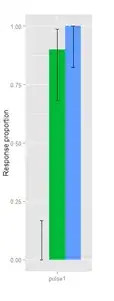I am fitting a generalized linear model (glm). The explanatory variable is categorical with three levels (control, treat1, treat2). The response variable is 0 or 1. The response rate for each treatment level is ploted as the figure below (from left to right: control, treat1, treat2):

There seems to be a big treatment effect between treat1 vs. control and treat2 vs. control. I applied glm:
fit <- glm(response ~ treatment, family = binomial, data = dat)
Coefficients:
Estimate Std. Error z value Pr(>|z|)
(Intercept) -21.57 6536.57 -0.003 0.997
treat1 23.76 6536.57 0.004 0.997
treat2 43.13 9364.95 0.005 0.996
The z-test shows that neither treat1 nor treat2 is significant compared to the reference level control.
However, the analysis of deviance confirmed that the treatment factor as a whole is highly significant:
drop1(M2, test="Chisq")
response ~ treatment
Df Deviance AIC LRT Pr(>Chi)
<none> 13.003 19.003
treatment 2 77.936 79.936 64.932 7.946e-15 ***
How shall I interpret such a strange result? Why does the individual z-test not give me any significant result, while according to the plot there is obviously an effect between treat1 and control, and between treat2 and control?